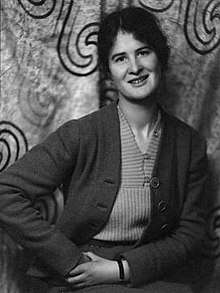Helen Muspratt
Helen Margaret Muspratt (13 May 1907 – 29 July 2001) was a British photographer.[1]
| Helen Muspratt | |
|---|---|
 | |
| Born | 13 May 1907 Chennai (India) |
| Died | 29 July 2001 Brighton |
| Occupation | Photographer |
| Spouse(s) | John Clement Dix Dunman |
Life
Born in Madras, India to British Army Lieutenant-Colonel Vivian Edward Muspratt and his wife, Lily May, née Hope.[2] She studied photography at Regent Street Polytechnic and in 1929 opened a photography studio in Swanage, Dorset. In 1932, she met Lettice Ramsey, and together they opened the Ramsey & Muspratt studio in Cambridge. In 1937, she married CPGB organiser Jack Dunman and opened a second Ramsey & Muspratt studio in Oxford.[3][4]
Helen Muspratt died on 29 July 2001 in Brighton, England.
Work
Early in her career, Muspratt pursued both portraiture (especially of children) and experimental work; her solarization studies were influenced by the American artist Man Ray. Her documentary work included travel to the Soviet Union in 1936 to photograph farmers and villagers along the Volga; upon her return, she joined the Communist Party in Britain. Commissioned by the Left Book Club in 1937, she photographed miners and unemployed laborers in the Rhondda valley in south Wales. In Oxford, portraiture was the mainstay of her commercial work until her retirement in the 1970s. In 1976, she held a retrospective exhibition of her work.[5][3] Wider recognition of her work came with the 1986–87 touring exhibition ‘Women's Photography in Britain’ and the volume The Other Observers : Women Photographers in Britain-1900 to the present;[6] in 1986, Channel 4 broadcast a documentary series on women photographers that featured Muspratt;[7] she also appeared in the BBC series Women of Our Century in 1990.[2]
The National Portrait Gallery, London holds fifteen of Muspratt's portrait photographs.[8]
Pallant House Gallery, Chichester, held an exhibition of her photographs in 2016.[9]
References
- Williams, Val (2 August 2001). "Helen Muspratt". The Independent. Retrieved 21 June 2020.
- Neale, Shirley (8 January 2009). Musgrave, Helen Margaret (1907–2001). Oxford Dictionary of National Biography. doi:10.1093/ref:odnb/76106. Retrieved 30 January 2018.
- "Helen Muspratt: The woman who photographed the Cambridge spies". The Independent. 1 March 2016. Retrieved 9 November 2017.
- The Oxford premises of Ramsey & Muspratt had been a studio opened by Walter Benington on behalf of Elliott & Fry. "Walter Bennington Biography". National Portrait Gallery. Archived from the original on 22 February 2018. Retrieved 22 February 2018.
- Marsh, Jan (1 August 2001). "Obituary: Helen Muspratt". The Guardian. ISSN 0261-3077. Retrieved 9 November 2017.
- Williams, Val (1986). The Other Observers : Women Photographers in Britain-1900 to the present. London: Virago. ISBN 1853814202.
- "Helen Muspratt: Five Women Photographers" (A Broadside Production for Channel 4 (UK) Television). Vimeo. October–November 1986.
- "Helen Muspratt – Person – National Portrait Gallery". Npg.org.uk. Retrieved 9 November 2017.
- "Helen Muspratt: Photographer". Pallant House Gallery. Retrieved 7 February 2020.
External links
- "Photographer Helen Muspratt through the eyes of her daughter – OUPblog". Blog.oup.com. 14 May 2017. Archived from the original on 30 January 2018. Retrieved 6 December 2017.
- "Helen Muspratt: Photographer – Exhibition at Pallant House Gallery in Chichester". ArtRabbit.com. Archived from the original on 30 January 2018. Retrieved 6 December 2017.
- "Helen Muspratt: Photographer". Rps.org. Archived from the original on 30 January 2018. Retrieved 6 December 2017.
- "Face: shape and angle: Helen Muspratt, photographer". Oxford University Press. 6 December 2017. Retrieved 6 December 2017.
- Ramsey & Muspratt Gallery at Peter Lofts, successor to Ramsey & Muspratt in Post Office Terrace, Cambridge (1980).
- Portrait of Helen Muspratt in her studio by Fra Newbery c 1930.